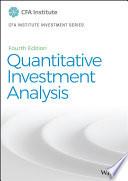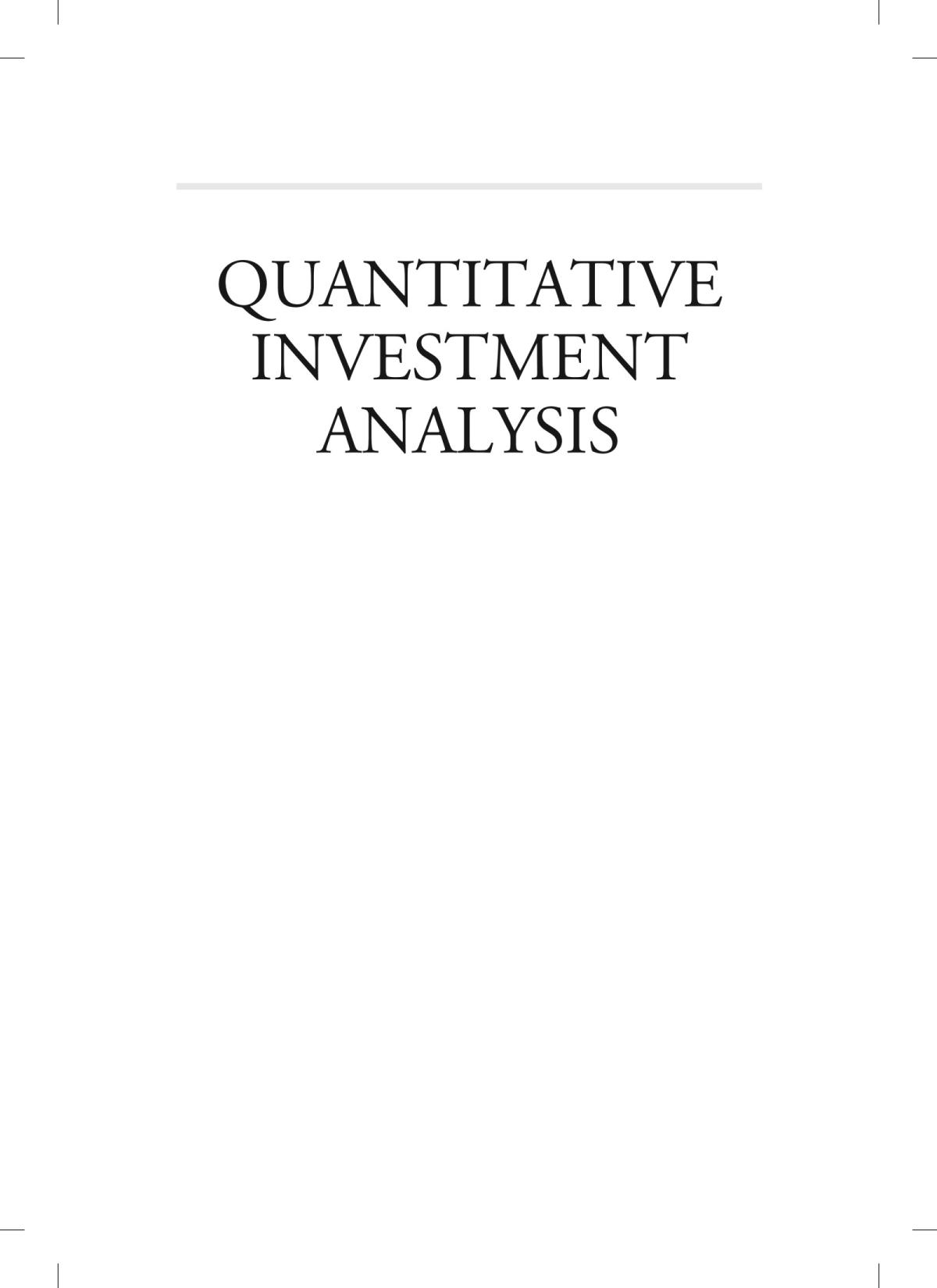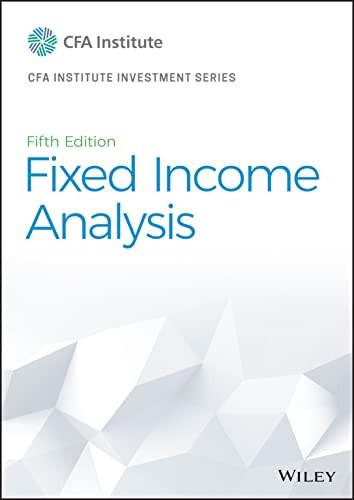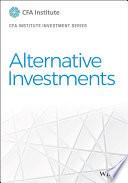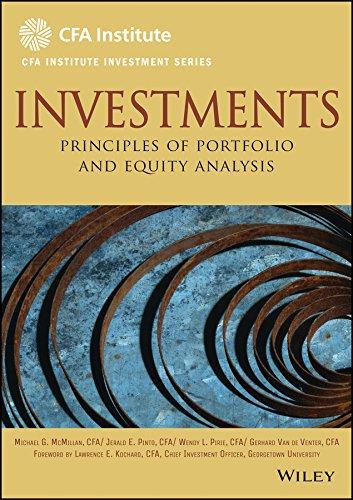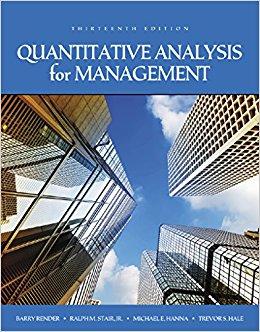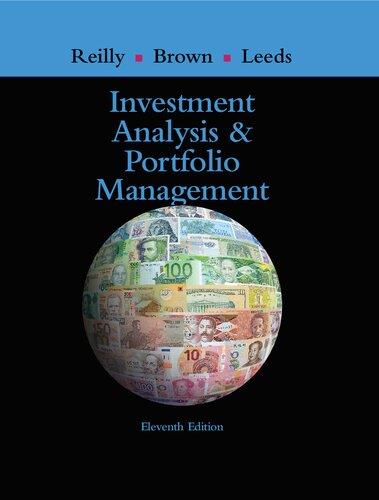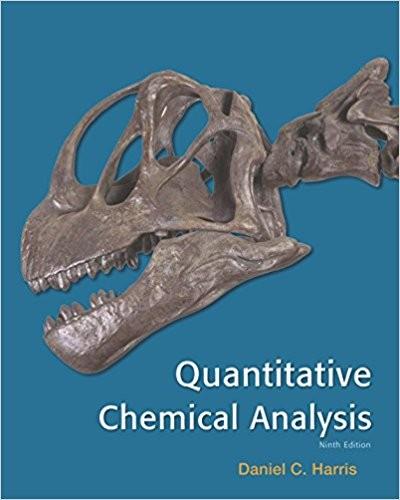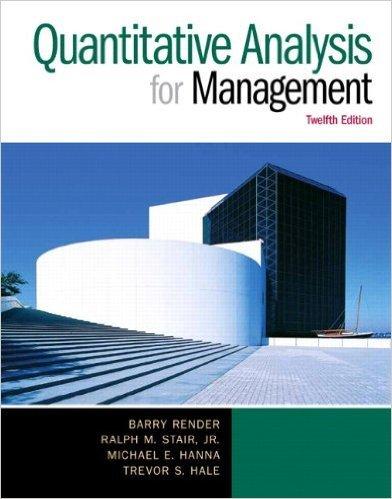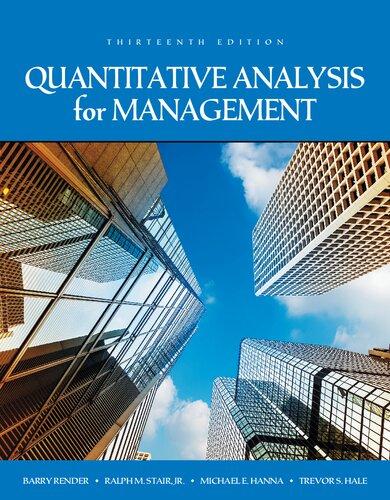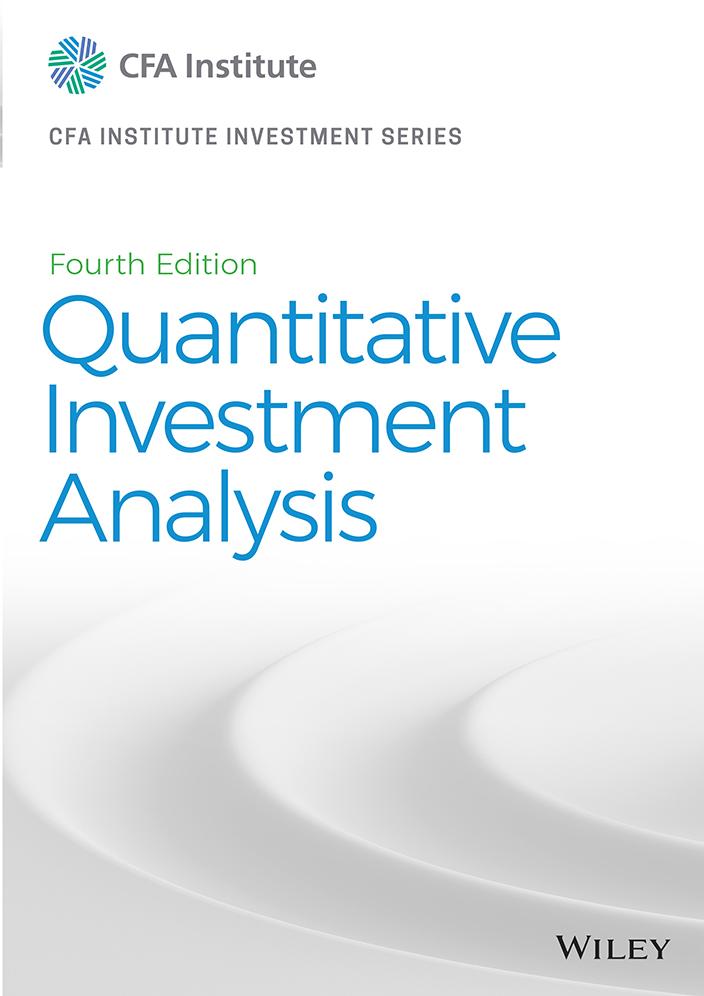Quantitative Investment Analysis, 4th Edition Cfa Institute Visit to download the full and correct content document: https://ebookmass.com/product/quantitative-investment-analysis-4th-edition-cfa-instit ute/
More products digital (pdf, epub, mobi) instant download maybe you interests ...
Quantitative Investment Analysis 4th Edition Cfa Institute https://ebookmass.com/product/quantitative-investmentanalysis-4th-edition-cfa-institute-2/
Fixed Income Analysis, 5th Edition Cfa Institute
https://ebookmass.com/product/fixed-income-analysis-5th-editioncfa-institute/
Alternatives Cfa Institute
https://ebookmass.com/product/alternatives-cfa-institute/
Investments: Principles of Portfolio and Equity Analysis (CFA Institute Investment Series Book 37) 1st Edition, (Ebook PDF)
https://ebookmass.com/product/investments-principles-ofportfolio-and-equity-analysis-cfa-institute-investment-seriesbook-37-1st-edition-ebook-pdf/
eTextbook Quantitative Analysis for Management 13th Edition
https://ebookmass.com/product/etextbook-quantitative-analysisfor-management-13th-edition/
Investment Analysis & Portfolio Management 11th Edition
Frank Reilly
https://ebookmass.com/product/investment-analysis-portfoliomanagement-11th-edition-frank-reilly/
(eTextbook PDF) for Quantitative Chemical Analysis 9th Edition
https://ebookmass.com/product/etextbook-pdf-for-quantitativechemical-analysis-9th-edition/
978-0133507331 Quantitative Analysis for Management (12th Edition)
https://ebookmass.com/product/978-0133507331-quantitativeanalysis-for-management-12th-edition/
Quantitative analysis for management Thirteenth Edition
Michael E. Hanna
https://ebookmass.com/product/quantitative-analysis-formanagement-thirteenth-edition-michael-e-hanna/
QUANTITATIVE INVESTMENT ANALYSIS CFAInstitute isthepremierassociationforinvestmentprofessionalsaroundtheworld,with over160,000membersin165countriesandterritories.Since1963theorganizationhas developedandadministeredtherenownedCharteredFinancialAnalyst®Program.Witha richhistoryofleadingtheinvestmentprofession,CFAInstitutehassetthehigheststandards inethics,education,andprofessionalexcellencewithintheglobalinvestmentcommunity andistheforemostauthorityoninvestmentprofessionconductandpractice.Eachbook intheCFAInstituteInvestmentSeriesisgearedtowardindustrypractitionersalongwith graduate-levelfinancestudentsandcoversthemostimportanttopicsintheindustry.The authorsofthesecutting-edgebooksarethemselvesindustryprofessionalsandacademics andbringtheirwealthofknowledgeandexpertisetothisseries.
QUANTITATIVE INVESTMENT ANALYSIS FourthEdition RichardA.DeFusco,CFA
DennisW.McLeavey,CFA
JeraldE.Pinto,CFA
DavidE.Runkle,CFA
Coverimage:©r.nagy/Shutterstock
Coverdesign:Wiley
Copyright©2004,2007,2015byCFAInstitute.Allrightsreserved.
PublishedbyJohnWiley&Sons,Inc.,Hoboken,NewJersey.
PublishedsimultaneouslyinCanada.
Nopartofthispublicationmaybereproduced,storedinaretrievalsystem,ortransmittedinanyformorbyany means,electronic,mechanical,photocopying,recording,scanning,orotherwise,exceptaspermittedunderSection 107or108ofthe1976UnitedStatesCopyrightAct,withouteitherthepriorwrittenpermissionofthePublisher, orauthorizationthroughpaymentoftheappropriateper-copyfeetotheCopyrightClearanceCenter,Inc.,222 RosewoodDrive,Danvers,MA01923,(978)750-8400,fax(978)646-8600,orontheWebatwww.copyright. com.RequeststothePublisherforpermissionshouldbeaddressedtothePermissionsDepartment,JohnWiley& Sons,Inc.,111RiverStreet,Hoboken,NJ07030,(201)748-6011,fax(201)748-6008,oronlineathttp://www. wiley.com/go/permissions.
LimitofLiability/DisclaimerofWarranty:Whilethepublisherandauthorhaveusedtheirbesteffortsinpreparing thisbook,theymakenorepresentationsorwarrantieswithrespecttotheaccuracyorcompletenessofthecontents ofthisbookandspecificallydisclaimanyimpliedwarrantiesofmerchantabilityorfitnessforaparticularpurpose. Nowarrantymaybecreatedorextendedbysalesrepresentativesorwrittensalesmaterials.Theadviceandstrategies containedhereinmaynotbesuitableforyoursituation.Youshouldconsultwithaprofessionalwhereappropriate. Neitherthepublishernorauthorshallbeliableforanylossofprofitoranyothercommercialdamages,including butnotlimitedtospecial,incidental,consequential,orotherdamages.
Forgeneralinformationonourotherproductsandservicesorfortechnicalsupport,pleasecontactourCustomer CareDepartmentwithintheUnitedStatesat(800)762-2974,outsidetheUnitedStatesat(317)572-3993,orfax (317)572-4002.
Wileypublishesinavarietyofprintandelectronicformatsandbyprint-on-demand.Somematerialincludedwith standardprintversionsofthisbookmaynotbeincludedine-booksorinprint-on-demand.Ifthisbookrefersto mediasuchasaCDorDVDthatisnotincludedintheversionyoupurchased,youmaydownloadthismaterialat http://booksupport.wiley.com.FormoreinformationaboutWileyproducts,visitwww.wiley.com.
ISBN978-1-119-74362-0(Hardcover) ISBN978-1-119-74365-1(ePDF) ISBN978-1-119-74364-4(ePub)
PrintedintheUnitedStatesofAmerica. 10987654321
CHAPTER1 TheTimeValueofMoney1 LearningOutcomes1
1.Introduction1
2.InterestRates:Interpretation2
3.TheFutureValueofaSingleCashFlow4
3.1.TheFrequencyofCompounding9
3.2.ContinuousCompounding11
3.3.StatedandEffectiveRates12
4.TheFutureValueofaSeriesofCashFlows13
4.1.EqualCashFlows OrdinaryAnnuity14
4.2.UnequalCashFlows15
5.ThePresentValueofaSingleCashFlow16
5.1.FindingthePresentValueofaSingleCashFlow16
5.2.TheFrequencyofCompounding18
6.ThePresentValueofaSeriesofCashFlows20
6.1.ThePresentValueofaSeriesofEqualCashFlows20
6.2.ThePresentValueofanInfiniteSeriesofEqualCashFlows Perpetuity24
6.3.PresentValuesIndexedatTimesOtherthant=025
6.4.ThePresentValueofaSeriesofUnequalCashFlows27
7.SolvingforRates,NumberofPeriods,orSizeofAnnuityPayments27
7.1.SolvingforInterestRatesandGrowthRates28
7.2.SolvingfortheNumberofPeriods30
7.3.SolvingfortheSizeofAnnuityPayments31
7.4.ReviewofPresentandFutureValueEquivalence35
7.5.TheCashFlowAdditivityPrinciple37
8.Summary38 PracticeProblems39
CHAPTER2
Organizing,Visualizing,andDescribingData45
LearningOutcomes45 1.Introduction45
2.DataTypes46
2.1.NumericalversusCategoricalData46
2.2.Cross-SectionalversusTime-SeriesversusPanelData49
2.3.StructuredversusUnstructuredData50
3.DataSummarization54
3.1.OrganizingDataforQuantitativeAnalysis54
3.2.SummarizingDataUsingFrequencyDistributions57
3.3.SummarizingDataUsingaContingencyTable63
4.DataVisualization68
4.1.HistogramandFrequencyPolygon68
4.2.BarChart69
4.3.Tree-Map73
4.4.WordCloud73
4.5.LineChart75
4.6.ScatterPlot77
4.7.HeatMap81
4.8.GuidetoSelectingamongVisualizationTypes82
5.MeasuresofCentralTendency85
5.1.TheArithmeticMean85
5.2.TheMedian90
5.3.TheMode92
5.4.OtherConceptsofMean92
6.OtherMeasuresofLocation:Quantiles102
6.1.Quartiles,Quintiles,Deciles,andPercentiles103
6.2.QuantilesinInvestmentPractice108
7.MeasuresofDispersion109
7.1.TheRange109
7.2.TheMeanAbsoluteDeviation109
7.3.SampleVarianceandSampleStandardDeviation111
7.4.TargetDownsideDeviation114
7.5.CoefficientofVariation117
8.TheShapeoftheDistributions:Skewness119
9.TheShapeoftheDistributions:Kurtosis121
10.CorrelationbetweenTwoVariables125
10.1.PropertiesofCorrelation126
10.2.LimitationsofCorrelationAnalysis129 11.Summary132 PracticeProblems135
CHAPTER3 ProbabilityConcepts147
LearningOutcomes147
1.Introduction148
2.Probability,ExpectedValue,andVariance148
3.PortfolioExpectedReturnandVarianceofReturn171
4.TopicsinProbability180
4.1.Bayes’ Formula180
4.2.PrinciplesofCounting184
5.Summary188 References190 PracticeProblem190
CHAPTER4 CommonProbabilityDistributions195
LearningOutcomes195
1.IntroductiontoCommonProbabilityDistributions196
2.DiscreteRandomVariables196
2.1.TheDiscreteUniformDistribution198
2.2.TheBinomialDistribution200
3.ContinuousRandomVariables210
3.1.ContinuousUniformDistribution210
3.2.TheNormalDistribution214
3.3.ApplicationsoftheNormalDistribution220
3.4.TheLognormalDistribution222
4.IntroductiontoMonteCarloSimulation228
5.Summary231 References233 PracticeProblems234
CHAPTER5 SamplingandEstimation241
LearningOutcomes241
1.Introduction242
2.Sampling242
2.1.SimpleRandomSampling242
2.2.StratifiedRandomSampling244
2.3.Time-SeriesandCross-SectionalData245
3.DistributionoftheSampleMean248
3.1.TheCentralLimitTheorem248
4.PointandIntervalEstimatesofthePopulationMean251
4.1.PointEstimators252
4.2.ConfidenceIntervalsforthePopulationMean253
4.3.SelectionofSampleSize259
5.MoreonSampling261
5.1.Data-MiningBias261
5.2.SampleSelectionBias264
5.3.Look-AheadBias265
5.4.Time-PeriodBias266
6.Summary267 References269 PracticeProblems270
CHAPTER6
HypothesisTesting275
LearningOutcomes275
1.Introduction276
2.HypothesisTesting277
3.HypothesisTestsConcerningtheMean287
3.1.TestsConcerningaSingleMean287
3.2.TestsConcerningDifferencesbetweenMeans294
3.3.TestsConcerningMeanDifferences299
4.HypothesisTestsConcerningVarianceandCorrelation303
4.1.TestsConcerningaSingleVariance303
4.2.TestsConcerningtheEquality(Inequality)ofTwoVariances305
4.3.TestsConcerningCorrelation308
5.OtherIssues:NonparametricInference310
5.1.NonparametricTestsConcerningCorrelation:TheSpearman RankCorrelationCoefficient312
5.2.NonparametricInference:Summary313
6.Summary314 References317 PracticeProblems317
CHAPTER7
IntroductiontoLinearRegression327
LearningOutcomes327
1.Introduction328
2.LinearRegression328
2.1.LinearRegressionwithOneIndependentVariable328
3.AssumptionsoftheLinearRegressionModel332
4.TheStandardErrorofEstimate335
5.TheCoefficientofDetermination337
6.HypothesisTesting339
7.AnalysisofVarianceinaRegressionwithOneIndependentVariable347
8.PredictionIntervals350
9.Summary353 References354 PracticeProblems354
CHAPTER8
MultipleRegression365
LearningOutcomes365
1.Introduction366
2.MultipleLinearRegression366
2.1.AssumptionsoftheMultipleLinearRegressionModel372
2.2.PredictingtheDependentVariableinaMultiple RegressionModel376
2.3.TestingWhetherAllPopulationRegressionCoefficients EqualZero378
2.4.Adjusted R2 380
3.UsingDummyVariablesinRegressions381
3.1.DefiningaDummyVariable381
3.2.VisualizingandInterpretingDummyVariables382
3.3.TestingforStatisticalSignificance384
4.ViolationsofRegressionAssumptions387
4.1.Heteroskedasticity388
4.2.SerialCorrelation394
4.3.Multicollinearity398
4.4.Heteroskedasticity,SerialCorrelation,Multicollinearity: SummarizingtheIssues401
5.ModelSpecificationandErrorsinSpecification401
5.1.PrinciplesofModelSpecification402
5.2.MisspecifiedFunctionalForm402
5.3.Time-SeriesMisspecification(IndependentVariables CorrelatedwithErrors)410
5.4.OtherTypesofTime-SeriesMisspecification414
6.ModelswithQualitativeDependentVariables414
6.1.ModelswithQualitativeDependentVariables414
7.Summary422 References425 PracticeProblems426
CHAPTER9
Time-SeriesAnalysis451
LearningOutcomes451
1.IntroductiontoTime-SeriesAnalysis452
2.ChallengesofWorkingwithTimeSeries454
3.TrendModels454
3.1.LinearTrendModels455
3.2.Log-LinearTrendModels458
3.3.TrendModelsandTestingforCorrelatedErrors463
4.Autoregressive(AR)Time-SeriesModels464
4.1.Covariance-StationarySeries465
4.2.DetectingSeriallyCorrelatedErrorsinanAutoregressiveModel466
4.3.MeanReversion469
4.4.MultiperiodForecastsandtheChainRuleofForecasting470
4.5.ComparingForecastModelPerformance473
4.6.InstabilityofRegressionCoefficients475
5.RandomWalksandUnitRoots478
5.1.RandomWalks478
5.2.TheUnitRootTestofNonstationarity482
6.Moving-AverageTime-SeriesModels486
6.1.SmoothingPastValueswithan n-PeriodMovingAverage486
6.2.Moving-AverageTime-SeriesModelsforForecasting489
7.SeasonalityinTime-SeriesModels491
8.AutoregressiveMoving-AverageModels496
9.AutoregressiveConditionalHeteroskedasticityModels497
10.RegressionswithMorethanOneTimeSeries500
11.OtherIssuesinTimeSeries504
12.SuggestedStepsinTime-SeriesForecasting505 13.Summary507 References508 PracticeProblems509
CHAPTER10 MachineLearning527 LearningOutcomes527
1.Introduction527
2.MachineLearningandInvestmentManagement528
3.WhatisMachineLearning?529
3.1.DefiningMachineLearning529
3.2.SupervisedLearning529
3.3.UnsupervisedLearning531
3.4.DeepLearningandReinforcementLearning531
3.5.SummaryofMLAlgorithmsandHowtoChooseamongThem532
4.OverviewofEvaluatingMLAlgorithmPerformance533
4.1.GeneralizationandOverfitting534
4.2.ErrorsandOverfitting534
4.3.PreventingOverfittinginSupervisedMachineLearning537
5.SupervisedMachineLearningAlgorithms539
5.1.PenalizedRegression539
5.2.SupportVectorMachine541
5.3. K-NearestNeighbor542
5.4.ClassificationandRegressionTree544
5.5.EnsembleLearningandRandomForest547
6.UnsupervisedMachineLearningAlgorithms559
6.1.PrincipalComponentsAnalysis560
6.2.Clustering563
7.NeuralNetworks,DeepLearningNets,andReinforcementLearning575
7.1.NeuralNetworks575
7.2.DeepLearningNeuralNetworks578
7.3.ReinforcementLearning579
8.ChoosinganAppropriateMLAlgorithm589 9.Summary590 References593 PracticeProblems593
CHAPTER11
BigDataProjects597
LearningOutcomes597
1.Introduction597
2.BigDatainInvestmentManagement598
3.StepsinExecutingaDataAnalysisProject:FinancialForecasting withBigData599
4.DataPreparationandWrangling603
4.1.StructuredData604
4.2.Unstructured(Text)Data610
5.DataExplorationObjectivesandMethods617
5.1.StructuredData618
5.2.UnstructuredData:TextExploration622
6.ModelTraining629
6.1.StructuredandUnstructuredData630
7.FinancialForecastingProject:ClassifyingandPredicting SentimentforStocks639
7.1.TextCuration,Preparation,andWrangling640
7.2.DataExploration644
7.3.ModelTraining654
7.4.ResultsandInterpretation658
8.Summary664 PracticeProblems665
CHAPTER12
UsingMultifactorModels675
LearningOutcomes675
1.Introduction675
2.MultifactorModelsandModernPortfolioTheory676
3.ArbitragePricingTheory677
4.MultifactorModels:Types683
4.1.FactorsandTypesofMultifactorModels683
4.2.TheStructureofMacroeconomicFactorModels684
4.3.TheStructureofFundamentalFactorModels687
4.4.Fixed-IncomeMultifactorModels691
5.MultifactorModels:SelectedApplications695
5.1.FactorModelsinReturnAttribution696
5.2.FactorModelsinRiskAttribution698
5.3.FactorModelsinPortfolioConstruction703
5.4.HowFactorConsiderationsCanBeUsefulinStrategic PortfolioDecisions705 6.Summary706 References707 PracticeProblems708
CHAPTER13
MeasuringandManagingMarketRisk713
LearningOutcomes713
1.Introduction714
2.UnderstandingValueatRisk714
2.1.ValueatRisk:FormalDefinition715
2.2.EstimatingVaR718
2.3.AdvantagesandLimitationsofVaR730
2.4.ExtensionsofVaR733
3.OtherKeyRiskMeasures SensitivityandScenarioMeasures735
3.1.SensitivityRiskMeasures736
3.2.ScenarioRiskMeasures740
3.3.SensitivityandScenarioRiskMeasuresandVaR746
4.UsingConstraintsinMarketRiskManagement750
4.1.RiskBudgeting751
4.2.PositionLimits752
4.3.ScenarioLimits752
4.4.Stop-LossLimits753
4.5.RiskMeasuresandCapitalAllocation753
5.ApplicationsofRiskMeasures755
5.1.MarketParticipantsandtheDifferentRiskMeasuresTheyUse755
6.Summary764 References766 PracticeProblems766
CHAPTER14
BacktestingandSimulation775
LearningOutcomes775
1.Introduction775
2.TheObjectivesofBacktesting776
3.TheBacktestingProcess776
3.1.StrategyDesign777
3.2.RollingWindowBacktesting778
3.3.KeyParametersinBacktesting779
3.4.Long/ShortHedgedPortfolioApproach781
3.5.PearsonandSpearmanRankIC785
3.6.UnivariateRegression789
3.7.DoDifferentBacktestingMethodologiesTelltheSameStory?789
4.MetricsandVisualsUsedinBacktesting792
4.1.Coverage792
4.2.Distribution794
4.3.PerformanceDecay,StructuralBreaks,andDownsideRisk797
4.4.FactorTurnoverandDecay797
5.CommonProblemsinBacktesting801
5.1.SurvivorshipBias801
5.2.Look-AheadBias804
6.BacktestingFactorAllocationStrategies807
6.1.SettingtheScene808
6.2.BacktestingtheBenchmarkandRiskParityStrategies808
7.ComparingMethodsofModelingRandomness813
7.1.FactorPortfoliosandBMandRPAllocationStrategies814
7.2.FactorReturnStatisticalProperties815
7.3.PerformanceMeasurementandDownsideRisk819
7.4.MethodstoAccountforRandomness821
8.ScenarioAnalysis824
9.HistoricalSimulationversusMonteCarloSimulation828
10.HistoricalSimulation830
11.MonteCarloSimulation835
12.SensitivityAnalysis840
13.Summary848 References849 PracticeProblems849
PREFACE Wearepleasedtobringyou QuantitativeInvestmentAnalysis,FourthEdition,whichfocuses onkeytoolsthatareneededfortoday’sprofessionalinvestor.Inadditiontoclassicareas suchasthetimevalueofmoneyandprobabilityandstatistics,thetextcoversadvancedconceptsinregression,timeseries,machinelearning,andbigdataprojects.Thetextteaches criticalskillsthatchallengemanyprofessionals,andshowshowthesetechniquescanbe appliedtoareassuchasfactormodeling,riskmanagement,andbacktestingandsimulation.
Thecontentwasdevelopedinpartnershipbyateamofdistinguishedacademicsand practitioners,chosenfortheiracknowledgedexpertiseinthefield,andguidedbyCFA Institute.Itiswrittenspecificallywiththeinvestmentpractitionerinmindandisreplete withexamplesandpracticeproblemsthatreinforcethelearningoutcomesanddemonstrate real-worldapplicability.
TheCFAProgramCurriculum,fromwhichthecontentofthisbookwasdrawn,issubjectedtoarigorousreviewprocesstoassurethatitis:
• Faithfultothefindingsofourongoingindustrypracticeanalysis
• Valuabletomembers,employers,andinvestors
• Globallyrelevant
• Generalist(asopposedtospecialist)innature
• Repletewithsufficientexamplesandpracticeopportunities
• Pedagogicallysound
TheaccompanyingworkbookisausefulreferencethatprovidesLearningOutcome Statementsthatdescribeexactlywhatreaderswilllearnandbeabletodemonstrateafter masteringtheaccompanyingmaterial.Additionally,theworkbookhassummaryoverviews andpracticeproblemsforeachchapter.
WeareconfidentthatyouwillfindthisandotherbooksintheCFAInstitute InvestmentSerieshelpfulinyoureffortstogrowyourinvestmentknowledge,whetheryou arearelativelynewentrantoranexperiencedveteranstrivingtokeepuptodateinthe ever-changingmarketenvironment.CFAInstitute,asalong-termcommittedparticipant intheinvestmentprofessionandanot-for-profitglobalmembershipassociation,ispleased toprovideyouwiththisopportunity.
ACKNOWLEDGMENTS Specialthankstoallthereviewers,advisors,andquestionwriterswhohelpedtoensurehigh practicalrelevance,technicalcorrectness,andunderstandabilityofthematerialpresented here.
Wewouldliketothankthemanyotherswhoplayedaroleintheconceptionandproductionofthisbook:theCurriculumandLearningExperienceteamatCFAInstitute,with specialthankstothecurriculumdirectors,pastandpresent,whoworkedwiththeauthors andreviewerstoproducethechaptersinthisbook;thePracticeAnalysisteamatCFA Institute;andthePublishingandTechnologyteamforbringingthisbooktoproduction.
ABOUTTHECFAINSTITUTE INVESTMENTSERIES CFAInstituteispleasedtoprovidetheCFAInstituteInvestmentSeries,whichcoversmajor areasinthefieldofinvestments.Weprovidethisbest-in-classseriesforthesamereasonwe havebeencharteringinvestmentprofessionalsformorethan45years:toleadtheinvestment professiongloballybysettingthehigheststandardsofethics,education,andprofessional excellence.
ThebooksintheCFAInstituteInvestmentSeriescontainpractical,globallyrelevant material.Theyareintendedbothforthosecontemplatingentryintotheextremelycompetitivefieldofinvestmentmanagementaswellasforthoseseekingameansofkeepingtheir knowledgefreshanduptodate.Thisserieswasdesignedtobeuserfriendlyandhighly relevant.
Wehopeyoufindthisserieshelpfulinyoureffortstogrowyourinvestmentknowledge,whetheryouarearelativelynewentrantoranexperiencedveteranethicallybound tokeepuptodateintheever-changingmarketenvironment.Asalong-term,committed participantintheinvestmentprofessionandanot-for-profitglobalmembershipassociation, CFAInstituteispleasedtoprovideyouwiththisopportunity.
THETEXTS CorporateFinance:APracticalApproach isasolidfoundationforthoselookingtoachieve lastingbusinessgrowth.Intoday’scompetitivebusinessenvironment,companiesmustfind innovativewaystoenablerapidandsustainablegrowth.Thistextequipsreaderswiththe foundationalknowledgeandtoolsformakingsmartbusinessdecisionsandformulatingstrategiestomaximizecompanyvalue.Itcoverseverythingfrommanagingrelationshipsbetween stakeholderstoevaluatingmergerandacquisitionbids,aswellasthecompaniesbehind them.Throughextensiveuseofreal-worldexamples,readerswillgaincriticalperspective intointerpretingcorporatefinancialdata,evaluatingprojects,andallocatingfundsinways thatincreasecorporatevalue.Readerswillgaininsightsintothetoolsandstrategiesused inmoderncorporatefinancialmanagement.
EquityAssetValuation isaparticularlycogentandimportantresourceforanyone involvedinestimatingthevalueofsecuritiesandunderstandingsecuritypricing.Awellinformedprofessionalknowsthatthecommonformsofequityvaluation dividenddiscountmodeling,freecashflowmodeling,price/earningsmodeling,andresidualincome modeling canallbereconciledwithoneanotherundercertainassumptions.Withadeep understandingoftheunderlyingassumptions,theprofessionalinvestorcanbetter
understandwhatotherinvestorsassumewhencalculatingtheirvaluationestimates.Thistext hasaglobalorientation,includingemergingmarkets.
FixedIncomeAnalysis hasbeenattheforefrontofnewconceptsinrecentyears,andthis particulartextofferssomeofthemostrecentmaterialfortheseasonedprofessionalwhois notafixed-incomespecialist.Theapplicationofoptionandderivativetechnologytothe oncestaidprovinceoffixedincomehashelpedcontributetoanexplosionofthoughtinthis area.Professionalshavebeenchallengedtostayuptospeedwithcreditderivatives,swaptions,collateralizedmortgagesecurities,mortgage-backedsecurities,andothervehicles,and thisexplosionofproductshasstrainedtheworld’sfinancialmarketsandtestedcentralbanks toprovidesufficientoversight.Armedwithathoroughgraspofthenewexposures,theprofessionalinvestorismuchbetterabletoanticipateandunderstandthechallengesourcentral bankersandmarketsface.
InternationalFinancialStatementAnalysis isdesignedtoaddresstheever-increasingneed forinvestmentprofessionalsandstudentstothinkaboutfinancialstatementanalysisfroma globalperspective.Thetextisapracticallyorientedintroductiontofinancialstatementanalysisthatisdistinguishedbyitscombinationofatrueinternationalorientation,astructured presentationstyle,andabundantillustrationsandtoolscoveringconceptsastheyareintroducedinthetext.Theauthorscoverthisdisciplinecomprehensivelyandwithaneyeto ensuringthereader’ssuccessatalllevelsinthecomplexworldoffinancialstatementanalysis.
Investments:PrinciplesofPortfolioandEquityAnalysis providesanaccessibleyetrigorous introductiontoportfolioandequityanalysis.Portfolioplanningandportfoliomanagement arepresentedwithinacontextofup-to-date,globalcoverageofsecuritymarkets,trading, andmarket-relatedconceptsandproducts.Theessentialsofequityanalysisandvaluation areexplainedindetailandprofuselyillustrated.Thebookincludescoverageofpractitionerimportantbutoftenneglectedtopics,suchasindustryanalysis.Throughout,thefocusison thepracticalapplicationofkeyconceptswithexamplesdrawnfrombothemergingand developedmarkets.Eachchapteraffordsthereadermanyopportunitiestoself-checkhisor herunderstandingoftopics.
AllbooksintheCFAInstituteInvestmentSeriesareavailablethroughallmajorbooksellers.And,alltitlesareavailableontheWileyCustomSelectplatformathttp://customselect. wiley.com/whereindividualchaptersforallthebooksmaybemixedandmatchedtocreate customtextbooksfortheclassroom.
CHAPTER 1 THETIMEVALUEOFMONEY RichardA.DeFusco,PhD,CFA
DennisW.McLeavey,DBA,CFA
JeraldE.Pinto,PhD,CFA
DavidE.Runkle,PhD,CFA
LEARNINGOUTCOMES Thecandidateshouldbeableto:
• interpretinterestratesasrequiredratesofreturn,discountrates,oropportunitycosts;
• explainaninterestrateasthesumofarealrisk-freerateandpremiumsthatcompensate investorsforbearingdistincttypesofrisk;
• calculateandinterprettheeffectiveannualrate,giventhestatedannualinterestrateand thefrequencyofcompounding;
• solvetimevalueofmoneyproblemsfordifferentfrequenciesofcompounding;
• calculateandinterpretthefuturevalue(FV)andpresentvalue(PV)ofasinglesumof money,anordinaryannuity,anannuitydue,aperpetuity(PVonly),andaseriesof unequalcashflows;
• demonstratetheuseofatimelineinmodelingandsolvingtimevalueofmoneyproblems.
1.INTRODUCTION Asindividuals,weoftenfacedecisionsthatinvolvesavingmoneyforafutureuse,or borrowingmoneyforcurrentconsumption.Wethenneedtodeterminetheamountweneed toinvest,ifwearesaving,orthecostofborrowing,ifweareshoppingforaloan.As investmentanalysts,muchofourworkalsoinvolvesevaluatingtransactionswithpresentand futurecashflows.Whenweplaceavalueonanysecurity,forexample,weareattemptingto determinetheworthofastreamoffuturecashflows.Tocarryoutalltheabovetasks
QuantitativeMethodsforInvestmentAnalysis,SecondEdition,byRichardA.DeFusco,PhD,CFA,Dennis W.McLeavey,DBA,CFA,JeraldE.Pinto,PhD,CFA,DavidE.Runkle,PhD,CFA.Copyright©2019 byCFAInstitute.
2QuantitativeInvestmentAnalysis accurately,wemustunderstandthemathematicsoftimevalueofmoneyproblems.Money hastimevalueinthatindividualsvalueagivenamountofmoneymorehighlytheearlieritis received.Therefore,asmalleramountofmoneynowmaybeequivalentinvaluetoalarger amountreceivedatafuturedate.The timevalueofmoney asatopicininvestment mathematicsdealswithequivalencerelationshipsbetweencashflowswithdifferentdates. Masteryoftimevalueofmoneyconceptsandtechniquesisessentialforinvestmentanalysts.
Thechapter1 isorganizedasfollows:Section2introducessometerminologyused throughoutthechapterandsuppliessomeeconomicintuitionforthevariableswewill discuss.Section3tacklestheproblemofdeterminingtheworthatafuturepointintimeofan amountinvestedtoday.Section4addressesthefutureworthofaseriesofcashflows.These twosectionsprovidethetoolsforcalculatingtheequivalentvalueatafuturedateofasingle cashfloworseriesofcashflows.Sections5and6discusstheequivalentvaluetodayofasingle futurecashflowandaseriesoffuturecashflows,respectively.InSection7,weexplorehowto determineotherquantitiesofinterestintimevalueofmoneyproblems.
2.INTERESTRATES:INTERPRETATION Inthischapter,wewillcontinuallyrefertointerestrates.Insomecases,weassumea particularvaluefortheinterestrate;inothercases,theinterestratewillbetheunknown quantityweseektodetermine.Beforeturningtothemechanicsoftimevalueofmoney problems,wemustillustratetheunderlyingeconomicconcepts.Inthissection,webriefly explainthemeaningandinterpretationofinterestrates.
Timevalueofmoneyconcernsequivalencerelationshipsbetweencashflowsoccurringon differentdates.Theideaofequivalencerelationshipsisrelativelysimple.Considerthe followingexchange:Youpay$10,000todayandinreturnreceive$9,500today.Wouldyou acceptthisarrangement?Notlikely.Butwhatifyoureceivedthe$9,500todayandpaidthe $10,000oneyearfromnow?Cantheseamountsbeconsideredequivalent?Possibly,because apaymentof$10,000ayearfromnowwouldprobablybeworthlesstoyouthanapayment of$10,000today.Itwouldbefair,therefore,to discount the$10,000receivedinoneyear; thatis,tocutitsvaluebasedonhowmuchtimepassesbeforethemoneyispaid.An interest rate,denoted r,isarateofreturnthatreflectstherelationshipbetweendifferentlydatedcash flows.If$9,500todayand$10,000inoneyearareequivalentinvalue,then$10,000 $9,500 ¼ $500istherequiredcompensationforreceiving$10,000inoneyearratherthan now.Theinterestrate therequiredcompensationstatedasarateofreturn is$500/ $9,500 ¼ 0.0526or5.26percent.
Interestratescanbethoughtofinthreeways.First,theycanbeconsideredrequiredrates ofreturn thatis,theminimumrateofreturnaninvestormustreceiveinordertoacceptthe investment.Second,interestratescanbeconsidereddiscountrates.Intheexampleabove, 5.26percentisthatrateatwhichwediscountedthe$10,000futureamounttofinditsvalue today.Thus,weusetheterms “interestrate” and “discountrate” almostinterchangeably. Third,interestratescanbeconsideredopportunitycosts.An opportunitycost isthevalue thatinvestorsforgobychoosingaparticularcourseofaction.Intheexample,ifthepartywho supplied$9,500hadinsteaddecidedtospendittoday,hewouldhaveforgoneearning
1Examplesinthis,andotherchapters,inthetextwereupdatedbyProfessorSanjivSabherwalofthe UniversityofTexas,Arlington.
5.26percentonthemoney.Sowecanview5.26percentastheopportunitycostofcurrent consumption.
Economicstellsusthatinterestratesaresetinthemarketplacebytheforcesofsupply anddemand,whereinvestorsaresuppliersoffundsandborrowersaredemandersoffunds. Takingtheperspectiveofinvestorsinanalyzingmarket-determinedinterestrates,wecanview aninterestrate r asbeingcomposedofarealrisk-freeinterestrateplusasetoffourpremiums thatarerequiredreturnsorcompensationforbearingdistincttypesofrisk:
r ¼ Realrisk-freeinterestrate þ Inflationpremium þ Defaultriskpremium þ Liquiditypremium þ Maturitypremium
• The realrisk-freeinterestrate isthesingle-periodinterestrateforacompletelyrisk-free securityifnoinflationwereexpected.Ineconomictheory,therealrisk-freeratereflectsthe timepreferencesofindividualsforcurrentversusfuturerealconsumption.
• The inflationpremium compensatesinvestorsforexpectedinflationandreflectstheaverage inflationrateexpectedoverthematurityofthedebt.Inflationreducesthepurchasingpower ofaunitofcurrency theamountofgoodsandservicesonecanbuywithit.Thesumof therealrisk-freeinterestrateandtheinflationpremiumisthe nominalrisk-freeinterest rate 2 Manycountrieshavegovernmentalshort-termdebtwhoseinterestratecanbe consideredtorepresentthenominalrisk-freeinterestrateinthatcountry.Theinterestrate ona90-dayUSTreasurybill(T-bill),forexample,representsthenominalrisk-freeinterest rateoverthattimehorizon.3 UST-billscanbeboughtandsoldinlargequantitieswith minimaltransactioncostsandarebackedbythefullfaithandcreditoftheUSgovernment.
• The defaultriskpremium compensatesinvestorsforthepossibilitythattheborrowerwill failtomakeapromisedpaymentatthecontractedtimeandinthecontractedamount.
• The liquiditypremium compensatesinvestorsfortheriskoflossrelativetoaninvestment’ s fairvalueiftheinvestmentneedstobeconvertedtocashquickly.UST-bills,forexample, donotbearaliquiditypremiumbecauselargeamountscanbeboughtandsoldwithout affectingtheirmarketprice.Manybondsofsmallissuers,bycontrast,tradeinfrequentlyafter theyareissued;theinterestrateonsuchbondsincludesaliquiditypremiumreflectingthe relativelyhighcosts(includingtheimpactonprice)ofsellingaposition.
• The maturitypremium compensatesinvestorsfortheincreasedsensitivityofthemarket valueofdebttoachangeinmarketinterestratesasmaturityisextended,ingeneral (holdingallelseequal).Thedifferencebetweentheinterestrateonlonger-maturity,liquid Treasurydebtandthatonshort-termTreasurydebtreflectsapositivematuritypremium forthelonger-termdebt(andpossiblydifferentinflationpremiumsaswell).
2Technically,1plusthenominalrateequalstheproductof1plustherealrateand1plustheinflationrate. Asaquickapproximation,however,thenominalrateisequaltotherealrateplusaninflationpremium.In thisdiscussionwefocusonapproximateadditiverelationshipstohighlighttheunderlyingconcepts.
3OtherdevelopedcountriesissuesecuritiessimilartoUSTreasurybills.TheFrenchgovernmentissues BTFsornegotiablefixed-ratediscountTreasurybills(BonsduTrésoràtauxfixeetàintérêtsprécomptés)with maturitiesofuptooneyear.TheJapanesegovernmentissuesashort-termTreasurybillwithmaturitiesof6 and12months.TheGermangovernmentissuesatdiscountbothTreasuryfinancingpaper (FinanzierungsschätzedesBundes or,forshort, Schätze)andTreasurydiscountpaper(Bubills)with maturitiesupto24months.IntheUnitedKingdom,theBritishgovernmentissuesgilt-edgedTreasury billswithmaturitiesrangingfrom1to364days.TheCanadiangovernmentbondmarketiscloselyrelated totheUSmarket;CanadianTreasurybillshavematuritiesof3,6,and12months.
Usingthisinsightintotheeconomicmeaningofinterestrates,wenowturntoadiscussionof solvingtimevalueofmoneyproblems,startingwiththefuturevalueofasinglecashflow.
3.THEFUTUREVALUEOFASINGLECASHFLOW Inthissection,weintroducetimevalueassociatedwithasinglecashfloworlump-sum investment.Wedescribetherelationshipbetweenaninitialinvestmentor presentvalue (PV),whichearnsarateofreturn(theinterestrateperperiod)denotedas r, andits future value(FV),whichwillbereceived N yearsorperiodsfromtoday.
Thefollowingexampleillustratesthisconcept.Supposeyouinvest$100(PV ¼ $100)in aninterest-bearingbankaccountpaying5percentannually.Attheendofthefirstyear,you willhavethe$100plustheinterestearned,0.05 $100 ¼ $5,foratotalof$105.To formalizethisone-periodexample,wedefinethefollowingterms:
PV ¼ presentvalueoftheinvestment
FVN ¼ futurevalueoftheinvestment N periodsfromtoday r ¼ rateofinterestperperiod
For N ¼ 1,theexpressionforthefuturevalueofamountPVis
¼ PV(1 þ r)(1)
Forthisexample,wecalculatethefuturevalueoneyearfromtodayasFV1 ¼ $100(1.05) ¼ $105.
Nowsupposeyoudecidetoinvesttheinitial$100fortwoyearswithinterestearnedand creditedtoyouraccountannually(annualcompounding).Attheendofthefirstyear(the beginningofthesecondyear),youraccountwillhave$105,whichyouwillleaveinthebank foranotheryear.Thus,withabeginningamountof$105(PV ¼ $105),theamountatthe endofthesecondyearwillbe$105(1.05) ¼ $110.25.Notethatthe$5.25interestearned duringthesecondyearis5percentoftheamountinvestedatthebeginningofYear2.
Anotherwaytounderstandthisexampleistonotethattheamountinvestedatthe beginningofYear2iscomposedoftheoriginal$100thatyouinvestedplusthe$5interest earnedduringthefirstyear.Duringthesecondyear,theoriginalprincipalagainearnsinterest,as doestheinterestthatwasearnedduringYear1.Youcanseehowtheoriginalinvestmentgrows: The$5interestthatyouearnedeachperiodonthe$100originalinvestmentisknownas simple interest (theinterestratetimestheprincipal). Principal istheamountoffundsoriginally Originalinvestment$100.00
Interestforthefirstyear($100 0.05)5.00
Interestforthesecondyearbasedonoriginalinvestment($100 0.05)5.00
Interestforthesecondyearbasedoninterestearnedinthefirstyear(0.05 $5.00 interestoninterest) 0.25
Total $110.25
FV1
invested.Duringthetwo-yearperiod,youearn $10ofsimpleinterest.Theextra$0.25thatyou haveattheendofYear2istheinterestyouearnedontheYear1interestof$5thatyou reinvested.
Theinterestearnedoninterestprovidesthefirstglimpseofthephenomenonknownas compounding.Althoughtheinterestearnedontheinitialinvestmentisimportant,fora giveninterestrateitisfixedinsizefromperiodtoperiod.Thecompoundedinterestearned onreinvestedinterestisafarmorepowerfulforcebecause,foragiveninterestrate,itgrowsin sizeeachperiod.Theimportanceofcompoundingincreaseswiththemagnitudeofthe interestrate.Forexample,$100investedtodaywouldbeworthabout$13,150after 100yearsifcompoundedannuallyat5percent,butworthmorethan$20millionif compoundedannuallyoverthesametimeperiodatarateof13percent.
Toverifythe$20millionfigure,weneedageneralformulatohandlecompoundingfor anynumberofperiods.Thefollowinggeneralformularelatesthepresentvalueofaninitial investmenttoitsfuturevalueafter N periods:
(2) where r isthestatedinterestrateperperiodand N isthenumberofcompoundingperiods.In thebankexample,FV2 ¼ $100(1 þ 0.05)2 ¼ $110.25.Inthe13percentinvestment example,FV100 ¼ $100(1.13)100 ¼ $20,316,287.42.
Themostimportantpointtorememberaboutusingthefuturevalueequationisthatthe statedinterestrate, r,andthenumberofcompoundingperiods, N,mustbecompatible.Both variablesmustbedefinedinthesametimeunits.Forexample,if N isstatedinmonths,then r shouldbetheone-monthinterestrate,unannualized.
Atimelinehelpsustokeeptrackofthecompatibilityoftimeunitsandtheinterestrate pertimeperiod.Inthetimeline,weusethetimeindex t torepresentapointintimeastated numberofperiodsfromtoday.Thusthepresentvalueistheamountavailableforinvestment today,indexedas t ¼ 0.Wecannowrefertoatime N periodsfromtodayas t ¼ N.Thetime lineinFigure1showsthisrelationship.InFigure1,wehavepositionedtheinitial investment,PV,at t ¼ 0.UsingEquation2,wemovethepresentvalue,PV,forwardto t ¼ N bythefactor(1 þ r)N.Thisfactoriscalledafuturevaluefactor.Wedenotethefuture valueonthetimelineasFVandpositionitat t ¼ N.Supposethefuturevalueistobe receivedexactly10periodsfromtoday’sdate(N ¼ 10).Thepresentvalue,PV,andthefuture value,FV,areseparatedintimethroughthefactor(1 þ r)10.
Thefactthatthepresentvalueandthefuturevalueareseparatedintimehasimportant consequences:
FIGURE1 TheRelationshipbetweenanInitialInvestment,PV,andItsFutureValue,FV
• Wecanaddamountsofmoneyonlyiftheyareindexedatthesamepointintime.
• Foragiveninterestrate,thefuturevalueincreaseswiththenumberofperiods.
• Foragivennumberofperiods,thefuturevalueincreaseswiththeinterestrate.
Tobetterunderstandtheseconcepts,considerthreeexamplesthatillustratehowtoapplythe futurevalueformula.
EXAMPLE1TheFutureValueofaLumpSumwithInterimCash ReinvestedattheSameRate
Youaretheluckywinnerofyourstate’slotteryof$5millionaftertaxes.Youinvest yourwinningsinafive-yearcertificateofdeposit(CD)atalocalfinancialinstitution. TheCDpromisestopay7percentperyearcompoundedannually.Thisinstitution alsoletsyoureinvesttheinterestatthatrateforthedurationoftheCD.Howmuch willyouhaveattheendoffiveyearsifyourmoneyremainsinvestedat7percentfor fiveyearswithnowithdrawals?
Solution: Tosolvethisproblem,computethefuturevalueofthe$5millioninvestment usingthefollowingvaluesinEquation2:
$7,012,758 65
Attheendoffiveyears,youwillhave$7,012,758.65ifyourmoneyremainsinvestedat 7percentwithnowithdrawals.
Notethatinthisandmostexamplesinthischapter,thefactorsarereportedatsixdecimal placesbutthecalculationsmayactuallyreflectgreaterprecision. Forexample,thereported 1.402552hasbeenroundedupfrom1.40255173(thecalculationisactuallycarriedoutwith morethaneightdecimalplacesofprecisionbythecalculatororspreadsheet).Ourfinalresult reflectsthehighernumberofdecimalplacescarriedbythecalculatororspreadsheet.4
4Wecouldalsosolvetimevalueofmoneyproblemsusingtablesofinterestratefactors.Solutionsusing tabledvaluesofinterestratefactorsaregenerallylessaccuratethansolutionsobtainedusingcalculatorsor spreadsheets,sopractitionersprefercalculatorsorspreadsheets.
EXAMPLE2TheFutureValueofaLumpSumwithNoInterimCash
Aninstitutionoffersyouthefollowingtermsforacontract:Foraninvestmentof ¥2,500,000,theinstitutionpromisestopayyoualumpsumsixyearsfromnowatan 8percentannualinterestrate.Whatfutureamountcanyouexpect?
Solution: UsethefollowingdatainEquation2tofindthefuturevalue:
186
Youcanexpecttoreceive¥3,967,186sixyearsfromnow.
Ourthirdexampleisamorecomplicatedfuturevalueproblemthatillustratesthe importanceofkeepingtrackofactualcalendartime.
EXAMPLE3TheFutureValueofaLumpSum Apensionfundmanagerestimatesthathiscorporatesponsorwillmakea$10million contributionfiveyearsfromnow.Therateofreturnonplanassetshasbeenestimated at9percentperyear.Thepensionfundmanagerwantstocalculatethefuturevalueof thiscontribution15yearsfromnow,whichisthedateatwhichthefundswillbe distributedtoretirees.Whatisthatfuturevalue?
Solution: Bypositioningtheinitialinvestment,PV,at t ¼ 5,wecancalculatethe futurevalueofthecontributionusingthefollowingdatainEquation2:
¼ $10 million
¼ 9% ¼ 0 09 N ¼ 10
$10,000,000ð1 09Þ10 ¼ $10,000,000ð2 367364Þ ¼ $23,673,636 75
Thisproblemlooksmuchliketheprevioustwo,butitdiffersinoneimportant respect:itstiming.Fromthestandpointoftoday(t ¼ 0),thefutureamountof $23,673,636.75is15yearsintothefuture.Althoughthefuturevalueis10yearsfrom
FIGURE2 TheFutureValueofaLumpSum,InitialInvestmentNotat t ¼ 0
itspresentvalue,thepresentvalueof$10millionwillnotbereceivedforanotherfive years.
AsFigure2shows,wehavefollowedtheconventionofindexingtodayas t ¼ 0 andindexingsubsequenttimesbyadding1foreachperiod.Theadditional contributionof$10millionistobereceivedinfiveyears,soitisindexedas t ¼ 5 andappearsassuchinthefigure.Thefutu revalueoftheinvestmentin10yearsis thenindexedat t ¼ 15;thatis,10yearsfollowingthereceiptofthe$10million contributionat t ¼ 5.Timelineslikethisonecanbeextremelyusefulwhendealing withmore-complicatedproblems,especiallythoseinvolvingmorethanonecash flow.
Inalatersectionofthischapter,wewilldiscusshowtocalculatethevaluetodayofthe $10milliontobereceivedfiveyearsfromnow.Forthemoment,wecanuseEquation2. Supposethepensionfundmanagerin Example3 aboveweretoreceive$6,499,313.86today fromthecorporatesponsor.Howmuchwillthatsumbeworthattheendoffiveyears?How muchwillitbeworthattheendof15years? PV ¼ $6,499,313 86
r ¼ 9% ¼ 0:09
N ¼ 5
¼ $6,499,313 86ð1 09Þ5
¼ $6,499,313:86ð1:538624Þ
¼ $10,000,000 at the five-year mark and PV ¼ $6,499,313:86
r ¼ 9% ¼ 0:09
N ¼ 15
